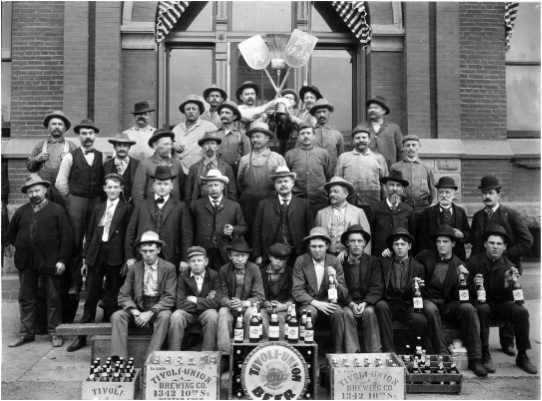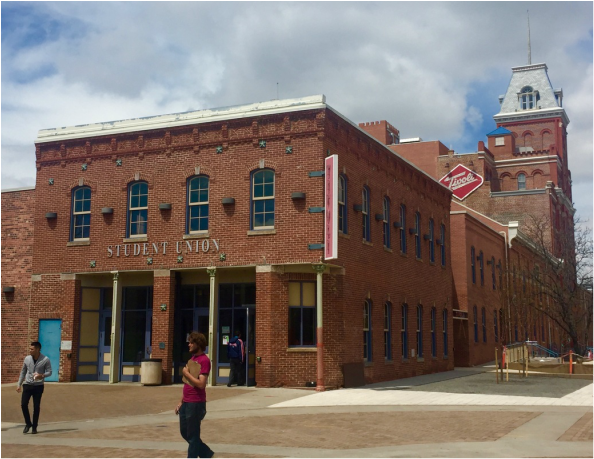In Spring of 2016 the History Museums: Exhibits and Education class at CU Denver took on creating three Auraria history projects. The first was to redo the exhibit hanging in the St. Cajetan's Church. The second was podcasts for historical walks around the campus. This online series of exhibits is part three of the class projects. We are giving you an overview through images and words of the history of both the original town and the campus. We hope you enjoy our work.
- Dr. Rebecca A. Hunt
Early Auraria: Native Peoples
By Elenie Louvaris
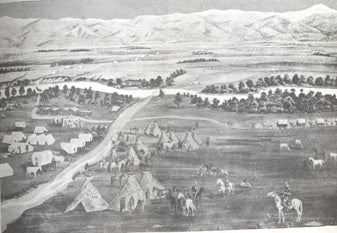
One of the earliest depictions of Auraria showing the Cherry Creek dividing prospectors looking for gold and the Cheyenne and Arapaho Indians who used the region as a camp site. Courtesy of Jerome Smiley, History of Denver, Rebecca Hunt Collection.
Native American's and The Greater Denver Area
While today, the three main tribes associated with the greater Denver area are the Cheyennes, Arapahoes, and the Utes, historically the land was inhabited by a much greater variety of native peoples. According to Sarah M. Nelson, in Denver: An Archeological History, pinpointing exactly who was in the greater Denver area is particularly difficult due to the transitory nature of the native groups in the region and a generally sparse archaeological record. Another factor to take into consideration is that as Europeans settled farther west, so did existing native groups.
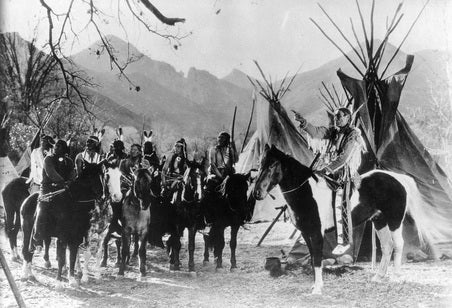 Picture Group of Arapaho men with Chief Goes-in-Lodge are staged during an early Tim McCoy film around the 1920s. Courtesy of Denver Public Library, Western History/Genealogy Department
Picture Group of Arapaho men with Chief Goes-in-Lodge are staged during an early Tim McCoy film around the 1920s. Courtesy of Denver Public Library, Western History/Genealogy Department
Displacement of Native Tribes
As Europeans settled in new territories, they displaced existing native tribes forcing them to move farther westward. These Natives then displaced existing native tribes. Essentially, the westward settlement of Europeans caused a chain reaction in the displacement of indigenous native tribes.
 Picture Group of Arapaho men pose with white settlers. Courtesy of Denver Public Library, Western History/Genealogy Department Natives and Euro-American Relationships
Picture Group of Arapaho men pose with white settlers. Courtesy of Denver Public Library, Western History/Genealogy Department Natives and Euro-American Relationships
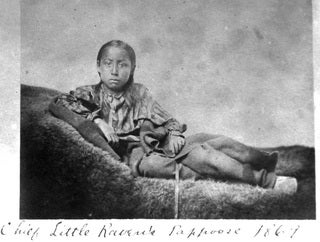
Picture Son, of Little Raven Chief of the Southern Arapahoes, poses for a photograph in the 1880s. Courtesy of Denver Public Library, Western History/Genealogy Department
Greater Denver Area Tribes
Many of the early tribes were offshoots or allies of each other, making it more difficult to differentiate between the tribes. The main groups who occupied the Denver area, however, were the Apaches, Utes, Cheyennes, Comanches and Arapahoes. At times Native peoples and Euro-Americans coexisted peacefully. Settlers often would marry Indian or Metis women creating mixed nation families. For example, William Rowland, an Auraria resident, married a Southern Cheyenne woman named Sis Frog. Additionally, American settlement on Native lands in the west sometimes led to hostility. This was furthered by institutions such as the Rocky Mountain News, which called Indians savages and uncivilized.
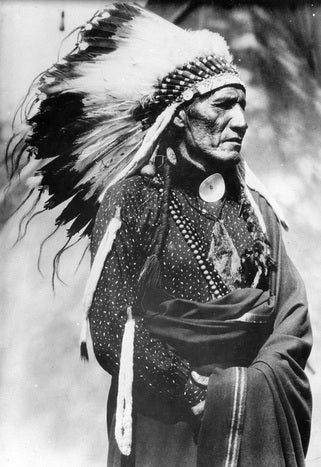
Picture Red Pipe, an Arapaho warrior, wearing traditional clothing in the late 1800s. Courtesy of Denver Public Library, Western History/Genealogy Department
Early Auraria: The Euro-American Community
Prospectors Settle in Auraria
By Elenie Louvaris
|
Auraria--originally a camp frequented by Arapaho Indians---was settled by prospectors where the Cherry Creek and South Platte meet. Prospectors and town builders, such as the Russell brothers, settled in Auraria in 1858 after finding seven ounces of gold in the South Platte. The discovery of gold led to the establishment of Auraria Town Company (ATC). Town founders were given parcels of land by ATC to form the town and later more land was donated to establish churches, sawmills, printing shops, and hotels. |
William Smedley, 1020 9th Street William Smedley, a Quaker, was the first dentist in Denver and lived at 1020 9th street until late in his life. Smedley's house is the oldest surviving building in 9th street park and was restored to reflect its original green and white frame from 1872. Smedley's property later became known as Casa Mayan, a restaurant owned by the Gonzalez family. Casa Mayan was a hub of Mexican-American culture. |
Cibola Hall: Auraria's Own Entertainment Hall
By Adam Cornett
Cibola Hall was one of the first entertainment venues in early Auraria. It was only the third combined drinking/gambling/theater establishment in the Denver area. The first entertainment venue was the Apollo Theater in Denver. To visit and attend, Auraria residents paid the toll for a ferry crossing. To remedy that, Cibola Hall, was built on modern day 11th Street between Wazee and Market Streets. The front half of the building was a saloon where patrons could drink and gamble. The back half was taken over by the Cibola Minstrels, a group of performing women who converted it into Reed’s Theater and began putting on their shows. The theater had 240 seats and was very popular with Auraria residents. In July of 1859, Cibola Hall was the site of a murder where a former slave and blacksmith, who had bought his freedom, was shot and killed over a dispute about whether he could play poker with a group of white men. Law enforcement never made any arrests. Cibola Hall had a reputation for being particularly shady in its practices. Many felt its primary business was to pull out-of-town miners in to gamble away their gold. It was exceedingly good at getting them to do so. The Cibola Hall location is now the Auraria athletic field, just to the west of the SpringHill Suites building on the Northeast corner of the modern campus.
Unlikely Roommates
By Sally Boelens

The original Rocky Mountain News and Uncle Dick Wootton’s rowdy "Western Saloon" once shared a building along Ferry Street, known today as 11th Street (if it continued through campus). It was a dangerous time to work for the Rocky Mountain News as customers below would shoot their pistols into the ceiling, just nearly missing the staff. The Rocky Mountain News Photo of the original Rocky Mountain News building. Photo courtesy of the Denver Public Library Western History and Genealogy Department. On April 23, 1859, Rocky Mountain News published their very first newspaper out of the attic of Uncle Dick Wooten’s saloon that once stood right on the present day athletic fields. The newspaper’s founders William Newton Byers, Thomas Gibson and John L. Dailey decided on the name Rocky Mountain News because they didn’t know which town they were going to settle in and wanted it to appeal to a larger audience. They chose the location because it had plank floors and glass windows, which was a rarity for the time. A different office location was chosen after the early Platte River flood destroyed the structure. More recently, the Rocky Mountain News closed its doors in 2008, just shy of its 150th birthday, but you can still witness one of the pages of the very first issue in the Denver Public Library.
Richens Lacy "Uncle Dick" Wootton
Richens Lacy “Uncle Dick” Wootton stopped in Denver in 1858. He came from Taos, New Mexico to the Denver to do some business. During his stop, he opened two barrels of “Taos Lightning” whiskey and openly shared it with the locals, for free! Legend says that by that very evening, he earned the name “Uncle Dick” for his generosity and became a favored friend among the locals. They urged him to stay, so that he did. He opened up a general store that was better known as the once popular and rowdy “Western Saloon” of the late 1850s and early 1860s.

Three men at classic saloon Although pictures of Uncle Dick Wootton's saloon did not survive, this illustrates what a saloon of the time period would have looked like.

Portrait of Uncle Dick Wootton Portrait of Richens "Uncle Dick" Wootton. Photo courtesy of Colorado Virtual Library: A Service of the Colorado State Library.
Getting An Education
By Emily Ferrufino-Coqueugniot
 Image from Smiley's History of Denver, from the Collection of Dr. Rebecca Hunt
Image from Smiley's History of Denver, from the Collection of Dr. Rebecca Hunt
When Auraria was still a neighborhood, there were several schools available for the local children. On the West side of Auraria, where the athletic fields are now located, there was the Union Sabbath School (near Market and 10th) and a Public School (near Market and 12th), both opened by Owen J. Goldrick. The Union Sabbath School was a Sunday school opened on October 3, 1859, open for all denominations and sects. It began with thirteen students under the direction of Professor Goldrick. Goldrick was one of Colorado's first teachers, becoming the founder of the public school system. In 1861, there was a push for the opening of a public school.
Image of O.J. Goldrick from Smiley's History of Denver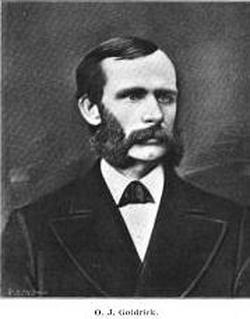
A Place To Rest Your Head: The Lindell Hotel
By Emily Ferrufino-Coqueugniot

An image of the Lindell Hotel from Smiley's History of Denver
The Lindell Hotel was once a well-respected hotel in Auraria and Denver, located at Eleventh and Larimer, a site which is now the Athletic Field on the west side of campus. It was once one of the biggest structures in town. Originally it was a trade store opened by the J.B. Doyle Company. When it opened the store had $30,000 worth of goods for sale. At the time the building contained a grocery store, a beer hall, a barber shop, and other businesses. Part of the hotel was razed in 1953. In 1891, the hotel was accused of operating a bar within 500 feet of the Washington School. By 1949, a Denver Post article claimed that the hotel was one of only three buildings in Auraria built before 1860 still standing on its original site.

View of the modern campus, showing some of the areas near the Lindell Hotel. From the collection of the Denver Public Library
Samuel Hawken: Auraria's Legendary Gunsmith
By Adam Cornett
Samuel Hawken and his brother Jacob were famous gunsmiths in St. Louis, Missouri during the first half of the nineteenth century. They developed the Hawken Plains Rifle in the 1820s which became very popular with frontiersmen for its power and accuracy. After Jacob died, Samuel, at age 67, moved from St. Louis to Auraria and opened a new shop right next door to the Pollack building at what is now 11th and Market. Hawken was immensely successful in Auraria since his shop was the only place to buy Hawken Rifles. He returned home to Missouri in in the mid-1870s and died in 1884. The site of his shop is in the Auraria Athletic Field and would be very close to where the Pollack building once stood, about one block North from where Eleventh Street now terminates.
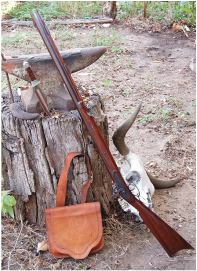 The Hawken Rifle, also known as the Buffalo Gun, was a very popular frontier weapon used by trappers and fur traders. It was lauded for its accuracy and "knock down" power while still being light enough to carry on long trips. This is the rifle that the Hawkens brothers developed, produced, and sold in their St. Louis gunsmith shop.
The Hawken Rifle, also known as the Buffalo Gun, was a very popular frontier weapon used by trappers and fur traders. It was lauded for its accuracy and "knock down" power while still being light enough to carry on long trips. This is the rifle that the Hawkens brothers developed, produced, and sold in their St. Louis gunsmith shop.
Auraria's First Immigrant Groups
By Aimee Wismar Germans
In Auraria, Germans began immigrating to Denver in the 1860s and quickly became the city’s largest foreign-born group. Many German immigrants settled in Auraria. From the 1860s until the early twentieth century, German immigrants were Denver’s most prosperous immigrant group. They opened bakeries, groceries, pickle factories, and, most importantly, breweries.
 Picture Brewers gather outside the Tivoli Brewing Company.
Picture Brewers gather outside the Tivoli Brewing Company.
Photo courtesy of the Denver Public Library Picture Image
courtesy of Thomas J. Noel St.
St. Elizabeth's Catholic Church
St. Elizabeth’s church was a pivotal German institution in the Auraria neighborhood. The church was founded by Franciscan brothers who built the church in 187?. Although the church was inten ded for the German population of Auraria, many of their new Irish neighbors also flocked to the church. This caused many tensions between the new and old immigrants, and just a year after the dedication of St. Elizabeth’s, the Irish population of Auraria petitioned to have their own church. By the early 1900s, the Auraria neighborhood was beginning to change. No longer was it a middle-class neighborhood. With the rise of industrialization in the area, Auraria became a working-class neighborhood, and the German population was replaced by Jewish and Hispanic immigrants.
The Irish in Auraria
The few Irish immigrants who settled in early Auraria were miners drawn to the area by the promise of gold and riches. As Auraria expanded(and eventually became co-opted by Denver) many Irish men worked as common laborers, while women worked as domestics, seamstresses or laundresses. Many Irish immigrants owned and operated taverns as well. Even though the Irish only represented three percent of the cities population, they operated ten percent of the city’s taverns. As the nineteenth century closed, the Irish population in Denver soared, and many were able to escape their menial jobs of the past. They became police officers, firefighters, business owners and politicians. Eventually the Irish left the working-class Auraria neighborhood and moved to middle-class sections of the city, but they left their permanent mark on the neighborhood.
Picture 1045-47 Ninth Street was built in 1890 by William F. Shulz, a German immigrant, and bookkeeper for the Tivoli Brewing Company. A prominent Irish immigrant, Eugene Madden once lived at 1047 Ninth Street. Madden was a Denver City Councilman, proprietor of Madden’s Dry Goods, and owner of a popular Auraria saloon. Image courtesy of Aimee Wismar Picture Photo Courtesy of Denver Public Library
St. Leo's Catholic Church The Catholic Church was an important feature for the Irish living in the Auraria neighborhood. Initially, the Irish shared St. Elizabeth’s Catholic Church with the German immigrants living in the neighborhood, but social and ethnic tensions between the groups led the Irish to request their own church in the area. St. Leo’s was funded, in part, by John K. Mullen, and was consecrated in 1890. In the early years of the church, St. Leo’s was one of the most successful Catholic churches in the city, with over 2500 parishioners, but by the early twentieth century, many of the Irish who had lived in Auraria had moved. Hispanics had begun to move into the neighborhood as well. For a period, the Irish and Hispanics shared St. Leo’s, with the Hispanic services being held in the basement. In 1925 Mullen helped finance the building of St. Cajetan’s so the Hispanic population of Auraria would have their own place to worship. Because many of the Irish families had moved from the neighborhood, St. Leo’s permanently in 1965. The church was town down with the building of the new campus, and the Auraria Technology building stands where St. Leo’s once was.
John Kernan Mullen, Businessman and Philanthropist
By Janet Dubois
 Nine year old John Mullen arrived in America from Ireland with his family in 1856. They settled in New York where John learned the trade of miller. At age nineteen, John went west to Kansas to work. In 1871 he moved on to Denver, Colorado. He was an experienced miller, but found it hard to obtain a job in the milling industry in Denver. He eventually went to work for O. W Shackleton and Charles Davis at their West Denver Flour Mill. As a progressive businessman Mullen built the Colorado Milling and Elevator Company and bought the Excelsior Mill from John W. Smith.
Nine year old John Mullen arrived in America from Ireland with his family in 1856. They settled in New York where John learned the trade of miller. At age nineteen, John went west to Kansas to work. In 1871 he moved on to Denver, Colorado. He was an experienced miller, but found it hard to obtain a job in the milling industry in Denver. He eventually went to work for O. W Shackleton and Charles Davis at their West Denver Flour Mill. As a progressive businessman Mullen built the Colorado Milling and Elevator Company and bought the Excelsior Mill from John W. Smith.
Photo courtesy of the Denver Public Library
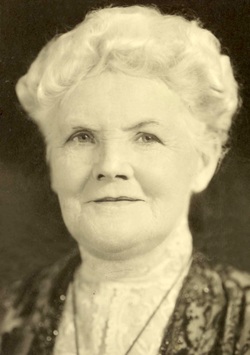 Catherine Smith was born in Cavan County, Ireland in 1851. She immigrated with her widowed mother and three older brothers to America in 1854. The family settled in Iowa, then Kansas. In 1864, they settled in Central City, Colorado. Kate and her mother, faithful Irish Catholics, were very involved in the Central City Irish Catholic community. Eventually, Kate moved to Denver and in 1874 married John K. Mullen.
Catherine Smith was born in Cavan County, Ireland in 1851. She immigrated with her widowed mother and three older brothers to America in 1854. The family settled in Iowa, then Kansas. In 1864, they settled in Central City, Colorado. Kate and her mother, faithful Irish Catholics, were very involved in the Central City Irish Catholic community. Eventually, Kate moved to Denver and in 1874 married John K. Mullen.
Catherine Smith Mullen
Photo Courtesy Denver Public Library
 Hungarian Mill
Hungarian Mill
Once Mullen became successful, he built the Hungarian Mills, Elevator and Ware House between Seventh and Eighth Streets on Wazee. By 1882, Mullen was “the leading flour producer in Colorado.”
Photo Courtesy Denver Public Library

Former Mullen Home
 St. Cajetan’s Catholic Church 1960s. Photo Courtesy Rebecca Hunt
St. Cajetan’s Catholic Church 1960s. Photo Courtesy Rebecca Hunt
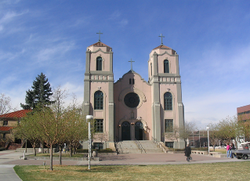 Photo Courtesy Denver Public Library
Photo Courtesy Denver Public Library
The Mullens were known for their philanthropy and in 1924, Catherine Mullen donated the Mullen's former home at Ninth and Lawrence Streets to build St. Cajetan's Catholic Church for the growing number of Hispanics who were living in the Auraria neighborhood in the 1920s. In 1925, the basement of the church was finished, but funds had run out. Because Catherine Mullen was an avid supporter of the new church, J. K. “felt compelled to provide support to the parish in her memory" when she died that year. He donated more than $65,000 to the church to help cover the remaining building costs. St. Cajetan’s Catholic Church was completed in 1926.
Rising Waters: Flooding and the Auraria Community
By: Brittany Huner
Ever since the beginning of the towns of Auraria and Denver, the nearby Cherry Creek and South Platte River have created problems for the town with numerous floods.
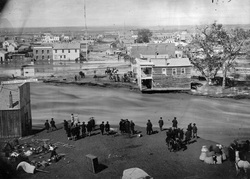 The first flood recorded in Denver occurred in May 1864 when heavy rain caused both Cherry Creek and the South Platte River to flood. Nineteen citizens died and the flood caused several thousands of dollars of damage. This was a large sum of money to the city at the time.
The first flood recorded in Denver occurred in May 1864 when heavy rain caused both Cherry Creek and the South Platte River to flood. Nineteen citizens died and the flood caused several thousands of dollars of damage. This was a large sum of money to the city at the time.
Photo of flooded Cherry Creek in Denver in 1864.
People watching water from banks of the flood
during the 1864 Cherry Creek Flood.
Photo courtesy of the George Wakely Collection at
Denver Public Library. Denver's "First Flood," May 1864.
Early Attempt at Prevention: The Flood of July 1878 The flood of 1878 resulted in Denver's first attempt to take major action for flood prevention. Denver attempted to turn Cherry Creek in a more western direction. Unfortunately, an injunction from Arapahoe County terminated the early flood prevention attempt. Flood of 1912 After a heavy storm on the afternoon of July 14, 1912, the water level of Cherry Creek rose dramatically and a heavy rush of water overtook the area. Two people who lived near the creek died and there was extensive property damage, mainly to warehouses and merchants whose goods were stored in basements near Cherry Creek. After the 1912 flood, city officials established the 1912 Flood Commission to investigate the floods and recommend steps for the city to take for future flood prevention.
Picture of 1864 Denver flood with several buildings and high water. Denver during the 1864 Cherry Creek flood. Photo courtesy of the W.G. Chamberlain Collection at Denver Public Library.
Castlewood Dam Finally Breaks: The 1933 Flood
One of the main concerns the 1912 Flood Commission expressed was the condition of the Castlewood Dam. The Denver Water Storage Company built the Castlewood Dam in 1890 and the dam leaked and frequently fell into disrepair. On August 3, 1933, the Castlewood Dam finally burst and flooded the Denver area. The flood caused approximately $1.7 million in damages for the city. Denver never rebuilt Castlewood Dam but constructed the Cherry Creek Dam to replace it in 1946.
Picture of destroyed Castlewood Dam after the
1933 break. Castlewood Dam after the 1933
break. Photo courtesy of the Harry Rhoads
Collection at Denver Public Library.
The Need for More Dams: The 1965 Flood Much like Denver's first flood in 1864, the flood in 1965 was the result of high waters in both the South Platte River and Cherry Creek. The 1965 flood caused approximately $540 million in damages to the city and the deaths of twenty-one people. After the 1965 flood, Denver Water built two more reservoirs at Chatfield and Bear Creek. The Future of Flooding in Denver and Auraria As long as the South Platte River and Cherry Creek exist, there will be flooding in the Denver and Auraria area. The city has taken numerous actions to prevent catastrophic flooding, including building several new dams and reservoirs. With every disastrous flood, the community has banded together in the wake of tragedy and grown stronger.
The Tivoli
By Aimee Wismar
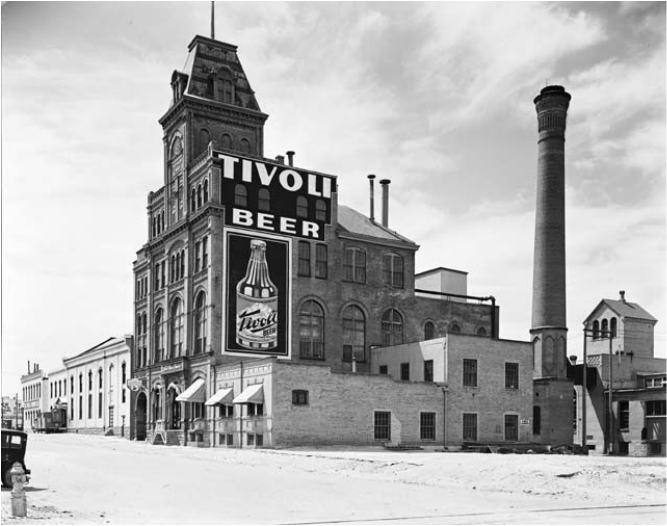
Exterior of the Tivoli Brewing Company circa 1938 or 1939. Image courtesy of the Denver Public Library Picture Image courtesy of the Denver Public Library
History of the Tivoli Brewing Company
 In 1866 Sigi Moritz, a German immigrant, opened the brewing company on Tenth Street between Market and Larimer Streets. He named it Sigi's. Moritz operated the brewery for a little over a decade until he sold it to Max Melsheimer, another German immigrant. Melsheimer renamed the brewery the Milwaukee Brewing Company and made many improvements to the property. Most of what is now the Tivoli Student Union was built during Melsheimer's tenure. He constructed the now iconic tower building, the Turnhalle, and the two adjoining buildings on the corner of Tenth and Larimer Streets. In 1900 Melsheimer sold the brewery to John Good, another German immigrant. Good renamed the brewery in honor of the Tivoli gardens in Copenhagen. The Good family operated the brewery until 1969 when, after the disastrous 1965 flood and a series of labor strikes, the brewery closed its doors for good.
In 1866 Sigi Moritz, a German immigrant, opened the brewing company on Tenth Street between Market and Larimer Streets. He named it Sigi's. Moritz operated the brewery for a little over a decade until he sold it to Max Melsheimer, another German immigrant. Melsheimer renamed the brewery the Milwaukee Brewing Company and made many improvements to the property. Most of what is now the Tivoli Student Union was built during Melsheimer's tenure. He constructed the now iconic tower building, the Turnhalle, and the two adjoining buildings on the corner of Tenth and Larimer Streets. In 1900 Melsheimer sold the brewery to John Good, another German immigrant. Good renamed the brewery in honor of the Tivoli gardens in Copenhagen. The Good family operated the brewery until 1969 when, after the disastrous 1965 flood and a series of labor strikes, the brewery closed its doors for good.
Photo courtesy of the Denver Public Library
The Tivoli and the German Community
With the industrialization emerging in West Denver, many German workers settled in Auraria to be close to work, and the Tivoli became the social center for the neighborhood. The Denver chapter of the Turnverein, a German gymnastics club, called Sigi’s brewery its headquarters during its early years. The Turnverein sponsored debates, scientific lectures, shooting competitions, traditional German feasts, and Oktoberfest. Turnverein leaders were also able to push legislation through the Colorado State Legislature that put physical education in public schools. In 1882 Melsheimer built the Turnhalle Opera house adjacent to the brewery. It served as a place where the Turnverein could hold music concerts, lectures, plays and debates.
Photo courtesy of the Denver Public Library
The Tivoli Becomes a Student Union
In 1973 officials placed the Tivoli on the National Register of Historic places. The Denver Urban Renewal Authority bought the building that same year and transferred ownership to the Auraria Higher Education Center(AHEC). But, when renovation costs skyrocketed, AHEC was forced to lease the building to a private development firm which built restaurants and shops in the complex. In 1991, Auraria students voted to buy back the lease on the Tivoli and use it as a student union. In 1994 the Tivoli was reopened. The Tivoli now houses restaurants, the campus bookstore, and study areas. The original Turnhalle is used for large meetings and conferences. In 2005 AHEC completed another renovation that restored the original red brick on the outside which had been hidden for seventy years.
Photo courtesy of Aimee Wismar
St. Cajetan's Church
By Shanea Ruybal
A Thriving Community
 The parish at St. Cajetan's Church helped the Hispanic community through tough times, was a center for the youth, and a place for people to come together to worship and socialize. In addition to the church, St. Cajetan's also offered a school and credit union for the Hispanic community
The parish at St. Cajetan's Church helped the Hispanic community through tough times, was a center for the youth, and a place for people to come together to worship and socialize. In addition to the church, St. Cajetan's also offered a school and credit union for the Hispanic community
“I remember a real sense of community.
There was lots of interaction and activity.
Weddings and funerals and births were
all celebrated as a community.”
—Tony Garcia
"[The] credit union was kind of the center
of the entire community. That's where
everybody went for all their banking needs.
It was right next door to the church."
- Don Vigil
Ramos Wedding at St. Cajetans. Denver Public Library - Latinos in Colorado Collection
St. Cajetan’s School
 In 1935, the Sisters of St. Benedict came from Wichita, Kansas to help the parish at St. Cajetan establish the St. Cajetan School. The school operated until 1970, when construction of the new Auraria Campus forced it to close. The King Center is now located on the old school’s site.
In 1935, the Sisters of St. Benedict came from Wichita, Kansas to help the parish at St. Cajetan establish the St. Cajetan School. The school operated until 1970, when construction of the new Auraria Campus forced it to close. The King Center is now located on the old school’s site.
“The lives of the Hispanic people revolved around their church. This was the place where they met weekly, made friends, and watched the children of all families grow. It was the weekly social and also the focus of many religious and secular holidays.” —Magdelena Gallegos
St. Cajetan's School. Denver Public Library Latinos in Colorado Collection.
 St. Cajetan's School Play. Denver Public Library Latinos/Hispanics in Colorado Collection
St. Cajetan's School Play. Denver Public Library Latinos/Hispanics in Colorado Collection
A New St. Cajetan's Church
Through the activism of the community, the people of Auraria saved the physical church from demolition in 1973. However, the congregation needed to relocate, and now meet at 299 Raleigh Street, in southwest Denver. St. Cajetan's on Raleigh Street

St. Cajetan's Church, about 1973, surrounded by
construction and demolition debris in anticipation
of future Auraria Campus site. Denver Public Library.
Latinos/Hispanics in Colorado Collection
Auraria's Displaced Peoples
By Shanea Ruybal
The Denver Urban Renewal Authority decided to build a campus in the Auraria community in the 1970s. This decision led to uprooting the entire community living in the Auraria neighborhood. Most of the residents in Auraria were of Hispanic descent. The community banded together to fight dislocation and ultimately lost in 1972.
The Hispanic community called Auraria their home since the 1910s. The Denver’s West side was a close community, full of color and life. It was home to many who felt disenfranchised in Anglo society, but in Auraria, they had a center. These people lost a battle that cut deeply into a culture’s soul.
Latinos/Hispanics in Colorado Collection The ARO Father Pete Garcia organized the Auraria Resident's Organization (ARO) to fight against the Urban Renewal Authority. The ARO organized protests, educating the community and partnered with Catholic churches and the Jewish community in Denver to try and stop the community's forced removal of their homes. The ARO felt confident they were winning the battle and were shocked when they lost. Lost Battle One Sunday, Archbishop James Casey sent a letter to all Catholic churches in Denver to read on the pulpit. The letter encouraged Catholics to vote for the bond issue. Many felt this was the reason the bond passed. This was a terrible loss for the people, who thought the church was on their side. Not only did people feel betrayed but they had now lost their homes. Leta Valdez and Isabel Nieto, walking hand in hand on 9th Street, 1949.
The residents of Auraria, even renters, were compensated for their homes. However, not all renters got their compensation and landlords just evicted them instead. One bright side, to this devastating tale, is that Auraria Higher Education Center promised all residents that the community and their descendants have access to a free education on the campus.
Find out more about the University of Colorado at Denver The University of Colorado Denver shuffled from home to home after opening in 1912. By the late 1950s, the University was just recently authorized to grant undergraduate and graduate degrees, but was still operating out of a renovated eight-story office tower and car barn previously known as the Denver Tramway Company. By the time the 1970s approached, the Tramway building was in serious need of renovation and the University of Colorado Denver student base was quickly outgrowing the space. Community College of Denver The Community College of Denver opened its doors in 1968. Prior to the Auraria campus, CCD was holding classes in two locations. One at 62nd and Downing, and another more centralized location in a former Kumpf Lincoln-Mercury Motor Showroom off of 11th and Acoma Street. Like Metro State College and the University of Colorado at Denver, they too were quickly outgrowing their space.
About
The CU Denver 4244/5244 - History Museums, Exhibits and Education class took on the task of digitally telling Auraria's history. CU Denver Professor:
Rebecca A. Hunt, Associate Professor C/T
CU Denver students:
- Brittany Huner
- Janet Dubois
- Shanea Ruybal
- Aimee Wismar
- Stephanie Reynolds
- Emily Ferrufino-Coqueugniot
- Adam Cornett
- Elenie Louvaris
- Sally Boelens




